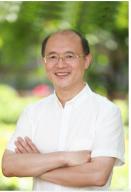
报告题目:植物气传性免疫的分子基础
报告时间:2024年10月17日 16:15 -17:15
报告地点:7-301报告厅
报告专家:刘玉乐、清华大学、教授/杰青
报告人简介
刘玉乐,清华大学生命科学学院,教授,国家杰出青年基金获得者。
1988-1998 中科院微生物所,实研、助研、副研、研究员
1998-1999 美国德克萨斯大学奥斯丁分校 博士后
1999-2006 美国耶鲁大学 博士后/ARS
2007-至今 清华大学生命科学学院,教授
长期从事植物病毒和细胞自噬相关研究,在植物抗病毒免疫、病毒病理、病毒载体、细胞自噬方面做出了有国际影响的工作。以通讯或第一作者在Nature、Cell、Cell Host&Microbe、Developmental Cell、EMBO Journal、Autophagy、Plant Cell、eLife、PLoS Pathogens、Annual Review of Virology等重要刊物发表论文60余篇,论文被谷歌学术共引用超过30190次,被Web of Science共引用超过18180次,主编教材《生物化学》(2023年),自2014年每年均入选爱思唯尔(Elsevier)发布的中国高被引学者榜单。
报告摘要
Aphids transmit viruses and are destructive crop pests. Plants that have been attacked by aphids release volatile compounds to elicit airborne defence (AD) in neighbouring plants. However, the mechanism underlying AD is unclear. Here we reveal that MeSA, SABP2, the transcription factor NAC2 and SAMT1 form a signalling circuit to mediate AD against aphids and viruses. Airborne MeSA is perceived and converted into salicylic acid by SABP2 in neighbouring plants. Salicylic acid then causes a signal transduction cascade to activate the NAC2–SAMT1 module for MeSA biosynthesis to induce plant anti-aphid immunity and reduce virus transmission. To counteract this, some aphid-transmitted viruses encode helicase-containing proteins to suppress AD by interacting with NAC2 to subcellularly relocalize and destabilize NAC2. As a consequence, plants become less repellent to aphids, and more suitable for aphid survival, infestation and viral transmission. Our findings uncover the mechanistic basis of AD and an aphid–virus co-evolutionary mutualism, demonstrating AD as a potential bioinspired strategy to control aphids and viruses.
代表性论文
1. Gong Q, Wang Y, He L, Huang F, Zhang D, Wang Y, Wei X, Han M, Deng H, Luo L, Cui F, Hong Y, Liu Y*. Molecular basis of methyl-salicylate-mediated plant airborne defence, Nature 622(7981):139-148, 2023
2. Yang M, Ismayil A, Jiang Z, Wang Y, Zheng X, Hong Y, Li D*, Liu Y*. A viral protein disrupts vacuolar acidification to facilitate virus infection in plants, EMBO Journal 41(2): e108713, 2022
3. Wang Y, Gong Q, Wu Y, Huang F, Ismayil A, Zhang D, Li H, Gu H, Ludman M, Fátyol, Qi Y, Yoshioka K, Hanley-Bowdoin L, Hong Y, Liu Y*. A calmo****n-binding transcription factor links calcium signaling to antiviral RNAi defense in plants, Cell Host & Microbe 29, 1393–1406, 2021
4. Ismayil A, Yang M, Haxima Y, Wang Y, Li J, Han L, Wang Y, Zheng X, Wei X, Nagalakshmi U, Hong Y, Hanley-Bowdoin L, Liu Y*. Cotton leaf curl Multan virus βC1 protein induces autophagy by disrupting the interaction of autophagy related protein 3 with Glyceraldehyde-3 Phosphate Dehydrogenases. Plant Cell 32(4):1124-1135, 2020
5. Liu Y, Schiff M, Czymmek K, Talloczy Z., Levine B and Dinesh-kumar SP. Autophagy regulates programmed cell death during the plant innate immune response, Cell 121(4), 567-577, 2005






 您的位置 :
您的位置 : 
